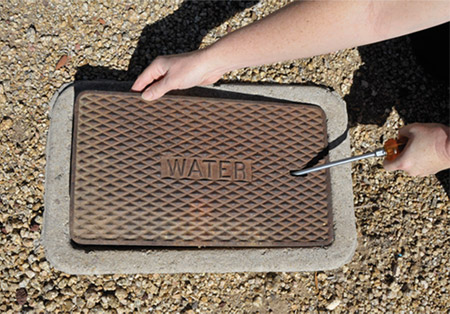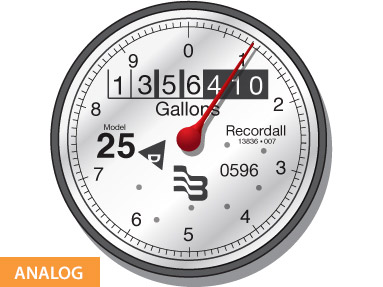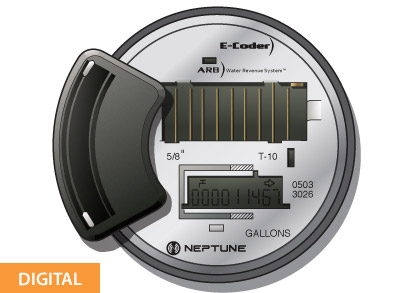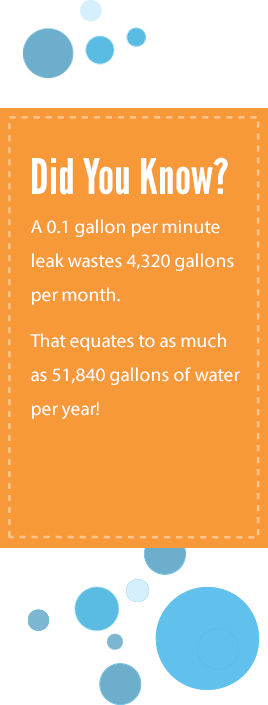How to Convert Water Meter Reading to Gallons
What is a Water Meter?
A water meter is a device that measures the volume of h2o delivered to a property. Some water meters measure water in gallons while others measure in cubic anxiety.
Well-nigh residential water meters are located virtually the curb or sidewalk at the forepart of the holding in a concrete "box." The water meter box volition have a metallic or plastic hat and may be marked, "Water Meter."
Use a long screwdriver to remove the lid. Withal, be cautious as insects, reptiles or other small animals occasionally take residence inside the boxes. Some water meters will have a small, hinged embrace while others may not. Lift the encompass and use a damp rag to wipe the face up make clean.
Next

Adjacent
Some water providers lock the lids of residential h2o meter boxes. If this is the case, you may demand to contact your provider or start with the visual inspections in Sections two and 3.
Understanding the Water Meter
Look at your h2o meter to decide if you have an analog (dial) or a digital display. Instructions for reading both types of water meters are included in this section.
Reading the Analog Display
The large sweep hand on the punch measures water use in gallons or cubic anxiety. One gallon or 1 cubic foot of h2o passes through the water meter every bit the sweep hand moves from ane number to the next (e.k., 0 to 1). A complete rotation equals 10 gallons or 10 cubic feet depending on the unit measured. Nearly analog dials have a low-flow indicator that turns as water moves through the water meter. This typically looks like a minor triangle (shown), star or gear.
Analog Example: The sweep hand is on the "ane" so the read is 1,356,411 gallons. The last number on the right is a static zero (does not change). When the sweep hand is on the "3" the read will be 1,356,413 gallons. When you record your reading in the Leak Detection Test, make sure to use the number indicated by the sweep arm as the final digit.

Activating and Reading the Digital Display (LCD)
The digital meter needs lite for activation then y'all may demand to smooth a flashlight on it. The display alternates between the meter read and the period rate. The meter read equals the gallons (or cubic feet) used while the flow charge per unit equals the number of gallons (or cubic anxiety) per minute flowing through the water meter. Some digital meters allow review of historical h2o use. This characteristic helps track water use trends such as when leaks take occurred. Check your water provider's website for more information.
Next

Next
Homes in Phoenix measure water use in cubic feet (marked on dial face). Ane cubic pes equals 7.48 gallons. Multiply the cubic feet by 7.48 to obtain the number of gallons.
Leak Detection Test
In one case you know how to read your h2o meter, you can begin to check for the presence of continuous leaks by following the procedure below. Do not utilize water or operate whatever h2o-using devices in or effectually your home during the test.
Step-by-Pace Instructions
For Analog Display Meters
- Detect the sweep hand. If information technology is moving, you have a continuous leak.
- Observe the low-menses indicator. If it is moving, y'all have a continuous leak.
- Some leaks are so minor that the movement is almost undetectable. To determine if you lot accept a slow leak:
- Read your water meter and record the numbers in the boxes we've provided ("Make full in your meter readings Fill in your meter readings"). Utilise the number indicated by the sweep arm as the final digit.
- Await twenty minutes then read your water meter again and record the numbers.
- Decrease the commencement water meter reading from the 2d.
- If Gallons Used is greater than naught you have a continuous leak.
For Digital Brandish (LCD) Meters
- Observe the flow rate screen for at least 10 flashes. If the number is greater than zero on any of the flashes, you accept a continuous leak.
- Some leaks are very slow and may not show as a continuous flow. To decide if you have a slow leak follow Footstep iii in a higher place.
Next
Case of the presence of a continuous leak:
2nd Read: - onest Read: = Gallons Used:
Fill in your meter readings:
Wait twenty minutes between taking meter readings. Enter readings below to determine number of gallons used.
twond Read: - 1st Read: = Gallons Used:

Next
Yous may want to confirm that no water utilise occurred during your examination, such as a flushed toilet or faucet use. Other possible reasons for pocket-sized amounts of h2o use include pool refill (autofill activated), evaporative cooler refill, icemaker refill, reverse osmosis (RO) arrangement regeneration or water softener regeneration. Consider turning off their water supplies.
Methods to Find the Location of Leaks
This guide provides two methods to discover the location of leaks: the Isolation Method and the Visual Inspection Method. A brief description of both methods follows.
Isolation Method

The purpose of the Isolation Method is to isolate different sections of the plumbing in and around your home. If your Leak Detection Test (Section 1) indicated a continuous leak, consider using the Isolation Method to discover the leak location. This is oft the quickest way to locate ongoing, difficult-to-detect leaks. Yous will turn water supply valves "off" to prevent water from flowing into h2o supply pipes. If y'all are comfortable turning valves on and off, go to Isolation Method for Continuous Leaks (Section four).
Visual Inspection Method
Conduct the Visual Inspection Method if you did non detect a continuous leak when you performed the Leak Detection Test (Section 1) or if you are uncomfortable with the Isolation Method. Utilise the checklists in the Outdoor Visual Leak Inspection (Section 2) and Indoor Visual Leak Inspection (Section 3) to carry visual leak inspections around your home.
CAUTION! Shut-off valves may fail or pause if they are old or corroded. You should just plough shut-off valves by paw.

Did You Know?
A 0.i gallon per minute leak wastes 4,320 gallons per month.
That equates to as much equally 51,840 gallons of h2o per yr!
How to Convert Water Meter Reading to Gallons
Source: https://www.smarthomewaterguide.org/how-to-read-your-water-meter